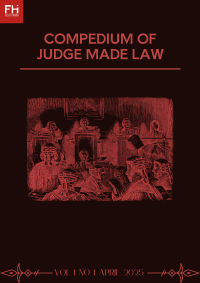Forced Defense (Noodweer) in Sexual Violence Crimes
DOI:
https://doi.org/10.56087/yeytnd35Keywords:
Forced Defense, Sexual Violence, Judge's DecisionAbstract
This study aims to determine and analyze whether the application of criminal law from the perpetrator of forced defense in decision no. 1 / Pid.Sus-Anak / 2020 / PN Kpn.This study uses a Normative research method, namely discussing the legal materials that have been obtained by referring to the existing theoretical basis.The results of this study indicate the results of the judge's decision that the legal fact was not revealed that the defendant committed his actions under duress to defend himself or others as regulated in Article 49 of the Criminal Code and the defendant was charged with Article 351 Paragraph 3 of the Criminal Code.The recommendation of this study refers to the consideration of the judge as a law enforcer, to pay more attention to everyone who carries out a forced defense, in the event of a criminal act, the perpetrator of the forced defense can bravely explain the actual incident to the person concerned, namely the police as law enforcer for the actions committed.
References
Asiva Noor Rachmayani, “KEKERASAN TERHADAP PEREMPUAN DAN ANAK DALAM PERSPEKTIF HUKUM DI INDONESIA,” Univ. Bengkulu, p. 6, 2015.
T. Kurniawan, “Peran Parlemen Dalam Perlindungan Anak,” J. DPR, vol. 6, no. 1, pp. 37–51, 2021, [Online]. Available: https://jurnal.dpr.go.id/index.php/aspirasi/article/view/467
F. Wahyuni, Dasar dasar Hukum Pidana Di Indonesia. 2017.
S. Nur Andini, T. Dijayanti, S. Fadilah, S. Safira Septhianova, and U. Maskanah, “Perlindungan Hukum Tindakan Pembelaan Terpaksa yang Melampaui Batas (Noodweer Exces) oleh Korban Kekerasan Seksual,” no. 2023, pp. 1–10, 2024, doi: 10.11111/dassollen.xxxxxxx.
C. A. I. Aleng, “Pengantar Tata Hukum Indonesia Herlina Manulang,” Lex Crim., vol. IX, pp. 63–68, 2020.
D. Iskandar, W. N. Zulbaidah, A. Almanda, and I. Abdinur, “Perkembangan Teori dan Penerapan Asas Legalitas dalam Hukum Pidana Indonesia,” vol. 1, no. 3, pp. 293–305, 2024.
A. Ilyas, Asas-asas hukum pidana. Rangkang Education Yogyakarta & PuKAP-Indonesia, 2012.
K. Mertha, BUKU AJAR HUKUM PIDANA. 2016.
D. E. Purwoleksono, Hukum Pidana.
A. Rosidi, M. Zainuddin, and I. Arifiana, “Metode Dalam Penelitian Hukum Normatif Dan Sosiologis (Field Research),” J. Law Gov., vol. 2, no. 1, pp. 46–58, 2024.
D. Wenlly, “PEMBELAAN TERPAKSA (NOODWEER) DAN PEMBELAAN TERPAKSA YANG MELAMPAUI BATAS (NOODWEER AXCES) SEBAGAI ALASAN,” vol. V, no. 5, pp. 61–68, 2016.
Nurul Irfan, Hukum Pidana islam. 2015.
A. U. Chasanah, “PEMBELAAN TERPAKSA YANG MELAMPAUI BATAS (NOODWEER EXCES) DALAM HUKUM PIDANA INDONESIA PERSPEKTIF HUKUM PIDANA ISLAM,” IRWANDI SAMUDRA, no. 18913053, pp. 1–66, 2020.
D. P. Kermite, J. A. Kermite, and F. Tawas, “Kajian Terhadap Pembelaan Terpaksa (Noodweer) Dalam Tindak Pidana Kesusilaan Berdasarkan Pasal 49 Ayat (1) Kitab Undang-Undang Hukum Pidana,” Lex Priv., vol. IX, no. 4, p. 139, 2021.
Irwandi Samudra and Fachri Wahyudi, “Pandangan Hukum Pidana Terhadap Pembelaan Terpaksa yang Melampaui Batas (Noodweer Exces),” Wasatiyah J. Huk., vol. 4, no. 2, pp. 1–18, 2023, doi: 10.70338/wasatiyah.v4i2.131.
Downloads
Published
Issue
Section
License
Copyright (c) 2025 Andi Nurwiratma Akzanti, Mulyati Pawennei, Andi Cakra Cindrapole

This work is licensed under a Creative Commons Attribution-ShareAlike 4.0 International License.


